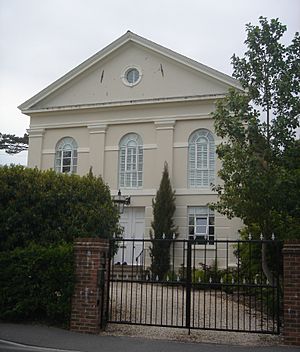Providence Strict Baptist Chapel, Burgess Hill facts for kids
Quick facts for kids Providence Strict Baptist Chapel |
|
|---|---|

The chapel from the south
|
|
| 50°57′32″N 0°08′08″W / 50.9590°N 0.1356°W | |
| Location | Park Road, Burgess Hill, West Sussex RH15 8EU |
| Country | England |
| Denomination | Baptist |
| History | |
| Status | Former chapel |
| Founded | 1875 |
| Founder(s) | Eli Ashdown, Frederick Hoadley |
| Architecture | |
| Functional status | Residential conversion |
| Heritage designation | Grade II |
| Designated | 27 November 1975 |
| Architect(s) | Simeon Norman |
| Style | Neoclassical |
| Completed | 1875 |
| Closed | 1999 |
The Providence Strict Baptist Chapel used to be a church for a group called Strict Baptists. It is located in the town of Burgess Hill in West Sussex, England.
It was built in 1875 by two important people from the town. Back then, many people in Sussex belonged to Protestant churches that weren't the main Church of England. The chapel was used for church services for over 100 years. In 1999, it was sold and turned into a family home.
The building has a Neoclassical style. It stands in a special area that protects its history, right across from Burgess Hill's main park. This building is considered very important for its design and history. It has a special status called "Grade II listed" by English Heritage.
Contents
History of Burgess Hill and the Chapel
Burgess Hill is now a town with about 30,000 people. But it didn't really exist until the middle of the 1800s. This was when the London and Brighton Railway built a railway line through an area called St John's Common.
The railway line and the Burgess Hill railway station opened in 1841. After that, more and more people moved to the area. This growth led to the building of an Anglican church, St John the Evangelist's, in the early 1860s. A new church area was created in 1863.
Who Built Providence Chapel?
One of the key people in early Burgess Hill was Frederick Hoadley. In 1857, he started a large shop near the railway station. It was very successful, and he opened other shops in Sussex.
In 1875, Frederick Hoadley and another resident named Eli Ashdown decided to build a Strict Baptist church. They set up a special fund to pay for it. St John's Park, a large green space in the town centre, was given to the town in 1871. Hoadley and Ashdown bought land on Park Road in 1875. This spot had a nice view looking south over the park.
They asked an architect named Simeon Norman to design the chapel. The chapel was officially registered for weddings on June 20, 1876.
Other Churches in Burgess Hill
Before the Providence Chapel, other churches were already in Burgess Hill. A Congregational church was built in 1829, even before the railway arrived. Groups like the Plymouth Brethren and General Baptists also started churches in 1870. By 1900, Methodists, Congregationalists, and the Salvation Army also had churches in the town.
The Chapel's Later Years
Simeon Norman's chapel continued to be used by the Strict Baptist community throughout the 1900s. However, fewer and fewer people attended services over time. Because of this, the chapel was sold in 1999. It has since been changed into a family home and is now called Providence House.
Why is it a Listed Building?
The Providence Strict Baptist Chapel was given a "Grade II listed" status by English Heritage on November 27, 1975. This means it is a "nationally important" building with "special interest." As of 2001, it was one of many listed buildings in the Mid Sussex area. It is also part of the St John's Common Conservation Area, which protects its historic surroundings.
Architecture and Design
The chapel was built in a style known as Classical or Neoclassical. It has two floors. On the top floor of the front, there are three windows with rounded tops, spaced evenly apart. Below these, there are two square-shaped windows on either side of the main entrance door.
Between these windows and doors, there are four tall, flat columns called pilasters. These columns are in the Doric style and have a triangular top part called a pediment. The building was originally covered with cement, but now it has a smooth finish called stucco.
See also

